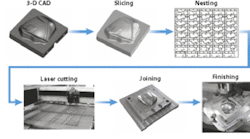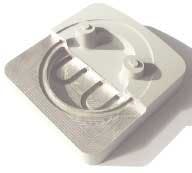Lamination welding
Multiple laser processing shows promise for the quick manufacturing of forming tools
For fast manufacturing of complex formed tools Fraunhofer IWS is working with industry partners on an automation solution for cutting, packaging and steel sheet cutouts. Along with the selection of the most suitable connecting technology, requirements must be considered for quality, surface quality and production costs. Deep drawing tools do not require a complete connection of the single metal sheets; instead a fast and economical connection is the main objective. Due to simple automation, laser beam welding is possible as a joining process. On the other hand, a temperature-steady connection of the sheet metal lamellas is necessary for injection molds, which can resist the injection pressures.
The MELATO (Metal Laminated Tooling) process provides for the production of injection molding dies or die casting tools. Three-dimensional CAD data of the tool to be manufactured are read into the CAD system, using standard interface formats (IGES, STL)(see Figure 1). Subsequently, the tool is sliced into single cross sections. In addition, the layer thickness that must be determined before is set, considering metal sheet tolerances or shrinkage of the soldering metal. After slicing, the single cross sections are arranged on a metal sheet panel. The cross-sections are cut out by laser beam and are, subsequently, joined by various bonding technologies. Strength and life of tools may be additionally improved, for example, by the finishing of critical edges by laser beam build-up welding. The tool is finished by milling, EDM, polishing and heat treatment.1
If a cooling system should need to be integrated in the tool, the tightness and heat conductivity of the laminated tool must be very high.2 Suitable connecting procedures are hard soldering and high-temperature brazing. MELATO tools, which are manufactured by high-temperature brazing, are hermetically sealed and possess good heat dissipation. After brazing, the laminated tool is finished by milling or polishing.
Bonding technology
With the layer technology it is possible to integrate complex tempering systems in injection molding tools or die-casting tools (see Figure 2). An optimization of the tools can be done by FEM-analysis or with a thermal image camera. In this way, the cycle time can be reduced dramatically and distortions of the parts are reduced because of the homogeneous tool temperature.
High-temperature brazing takes place in vacuum or in an inert gas atmosphere. The strength of the connections, from low to highly alloyed steel, reaches the strength of the basic materials. For the production of laminated tools for the high temperature range only high-temperature soldering metals on nickel basis are applicable due to the enormous thermal load, whose heat resistance is enough to 800° C.3
The metal sheets are manually released from oxide coatings and cleaned with ethanol and/or acetone. Subsequently, the up-sprayed soldering is dried (10 min with 120° C) in a furnace. Then, the lamella package is soldered in the furnace under inert gas atmosphere at 1060° C.
After the tool is soldered, finishing takes place by means of milling and polishing. Finally the tool is installed in the tool framework and tested with a project partner. In summary, the following statements can be made for testing:
- The laminated tool showed up compactly and the layer interfaces are almost non-porous.
- The integrated cooling system proved as suitable, no leakage occurred.
In these experiments, the cycle time with a conventionally manufactured and a laminated tool half could be reduced by 35 percent.
Laser beam welding
The layer structure of MELATO tools and the demand to integrate welding operations into the building process (automation) determine the selection of suitable welding methods. The heat entry into the part is relatively low with laser beam welding (small heat influence zone). The energy entry can be influenced by the parameters of laser power and welding time and/or welding speed. The welding operations can be automated and integrated in processing centers by the use of suitable CAD/CAM software. In order to do this, software was developed, which makes it possible to divide 3D CAD models into layers and to prepare the data for cutting. In addition, the position of weld spots is calculated automatically and weld defects, such as increased welding seam height, are compensated. This is done by cutting a hole in the following layer, at the position of the spots.4
Figure 4 shows a deep drawing tool manufactured by laser beam spot welding. The building and finishing of tools can take place directly in machining centers if laser beam welding equipment is integrated. This application uses modified 3-axes and 5-axes machining centers. The goal is the complete processing (laser beam welding, milling, laser cladding) of tools and parts in one set-up.
After the stair stepping effect was removed manually, about 25 parts could be manufactured with the laminated punch. Mild steel was used as material for the lamellas. The formed high-strength steel has a thickness of 1.5 mm, a tensile strength of 700 MPa and yield strength of about 400 MPa.
Summary
The investigation of laminated tooling has shown that this technology has the capability for rapid tooling of deep drawing, stamping and injection molding tools. For the different applications, various process chains have been developed.
Injection molds require a perfect bonding in order to produce a high surface quality and a dense connection of the lamellas. The investigations showed that the developed process chain for high-temperature brazing is suitable for the manufacturing of tools with integrated cooling systems.
Laser beam welding shows a high potential for the quick manufacturing of forming tools. For this application, special software was developed that is able to generate all necessary data for cutting and laser beam welding.
Further investigation is focused on the bonding technology for MELATO to enter new application areas such as pressure die casting. An automated solution for the generation of tools by laser beam welding is now being developed at Fraunhofer IWS.
Thomas Himmer ([email protected]) is with Fraunhofer USA Inc., Plymouth MI. Dr. Anja Techel, Dr. Stefen Nowotny and Prof. Dr. Eckhard Beyer are with Fraunhofer IWS, Dresden, Germany. Additional information can be found for Metal Laminated Tooling and Laser Build-Up Welding under: http://www.iws.fhg.de/projekte/051/e_pro051.html
Acknowledgements
This research and development project is founded by the German Federal Ministry of Education and Research (BMBF) within the framework concept "research for the production of tomorrow" and cared by the agency "Production and Production Technologies" (PFT) at the Forschungszentrum Karlsruhe.
References
- Himmer T., Techel A., Nowotny S., and Beyer E., "Recent Developments in Metal Laminated Tooling by Multiple Laser Processing," Proc. 13th Solid Freeform Fabrication Symposium, Austin/Texas, S. 466-473, August 2002.
- Nakagawa T., Kunieda, M., and Liu S. "Laser Cut Sheet Laminated Forming Dies by Diffusion Bonding," Proceedings of 25th International MTDR Conference, S. 505-510, 1985.
- Dorn L., "Hartlöten: Grundlagen u. Anwendungen," Expert Verlag Sindelfingen, 1985.
- Himmer T., Verfahren zum verzugsfreien Fügen von Blechen durch Laserstrahlschweiflen. DE-Patent: 102 11 511.




